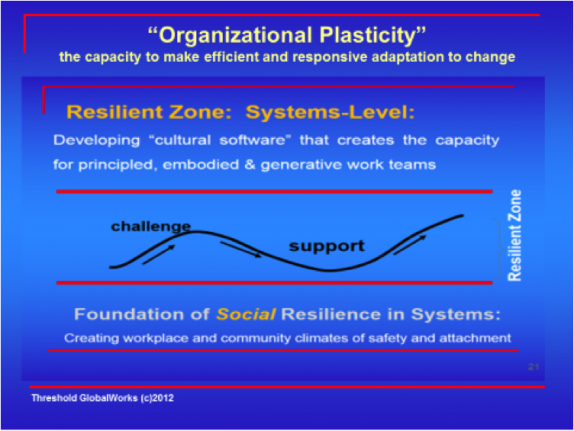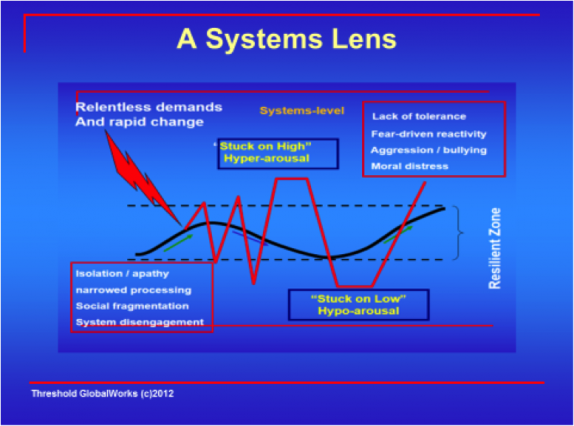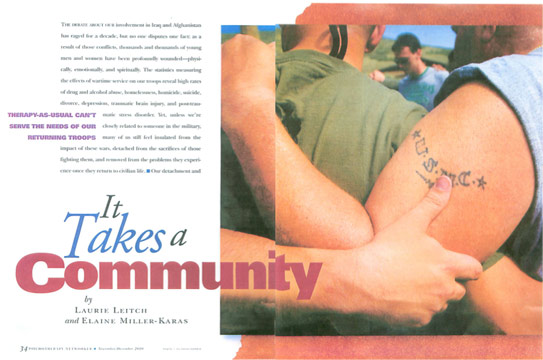As springtime gets underway we have been reflecting with gratitude and excitement on the ways in which our work is expanding and the many individuals and organizations that share our goal of building “communities that work.” We started Threshold GlobalWorks in order to expand beyond a focus on individual-level resilience to systems-level resilience. Work and community systems are shaped by and also shape the resilience of the individuals, work teams, and groups that comprise them. We know a lot about how to build individual resilience…but what creates organizational resilience?
Building nimble systems which are capable of swift mid-course corrections and collaborative action requires an organizational mindset and skill set that sees change not as a threat but as a challenge. When members of a system or enterprise believe they have the resources and skills needed to respond to emerging needs and challenges the system takes action from within its “Resilient Zone” (see below), the zone in which we respond rather than react, the zone in which decisions are made from a collaborative orientation to shared goals and values, the zone in which the collective nervous system is in balance.
In individuals, neuroscience research refers to “mental plasticity,” the capacity of the mind-body system to be flexible and adaptive when encountering the unexpected. A neuroscience template is useful as a way of understanding not only the individuals in a system but also the system as a whole.
What makes healthy, generative workplaces?
What builds “Organizational Plasticity?”
 By “Organizational Plasticity” we are referring to the “nervous system of a system” and its capacity to change in response to emerging needs/constraints/ realities.
By “Organizational Plasticity” we are referring to the “nervous system of a system” and its capacity to change in response to emerging needs/constraints/ realities.
The relentless change that characterizes the world today requires organizations to have both hardiness and flexibility, a willingness to create and adapt policies, programs, and practices that reflect a strong value system of principled behavior, collaboration, and curiosity about rather than resistance to the changing requirements of our highly networked and highly stressed systems.
Enterprises that take on the task of future-proofing their workplace see decreases in such overload indicators as staff burn-out, bullying and mobbing, moral distress, and on the positive side increased staff engagement, generativity, and lower turnover rates.
Our work in educational and healthcare settings, communities, and multinational organizations uses a curriculum that promotes resilience in individuals through neuroscience-based self-care skills and builds broad engagement and resilience in groups, work teams, and large systems by:
1) creating networks across organizational hierarchy and diversity,
2) implementing our curriculum focused on promoting “organizational plasticity,”
3) use of eHealth modules that empower wellness and generate scaleability.
4) design of social impact games that foster learning, cooperation and collaboration.
What kinds of factors shape the ability of entire enterprises to operate from within their Resilient Zone, our term for the zone of nervous system balance that provides the best capacity for integrative, collaborative functioning?
 Systems characterized by hyper-arousal, or that are “stuck on high” (see below) exhibit behaviors such as reactivity, angry outbursts, bullying, and stinginess. Systems primarily in hypo-arousal, or “stuck on low” (i.e., under-arousal) are characterized by lethargy, lack of engagement in work teams, apathy, and hopelessness. Many systems swing between the two extremes.
Systems characterized by hyper-arousal, or that are “stuck on high” (see below) exhibit behaviors such as reactivity, angry outbursts, bullying, and stinginess. Systems primarily in hypo-arousal, or “stuck on low” (i.e., under-arousal) are characterized by lethargy, lack of engagement in work teams, apathy, and hopelessness. Many systems swing between the two extremes.
Fortunately, it is possible to promote and sustain vibrant and humanizing workplaces that build upon existing strengths. This process requires leadership by example, top-down, bottom-up, and middle-out, to adopt self-regulation and self-awareness as core strengths and guide the implementation of resilience-oriented workplace practices.
As interconnectivity, global networks, and enterprise complexity increase it is an exciting challenge to develop workplace skills, practices, and structures that promote “Organizational Plasticity.” Organizations that build the capacity for agile and collaborative response to change create the potential to realize a triple bottom line: enhanced individual well-being, improved social resilience across work teams at all levels and gains in mission performance in terms of social impact and profits. In the marketplace competition may be necessary to survive but in today’s world collaboration is imperative to thrive.

